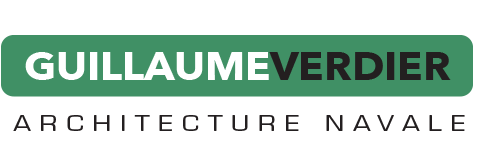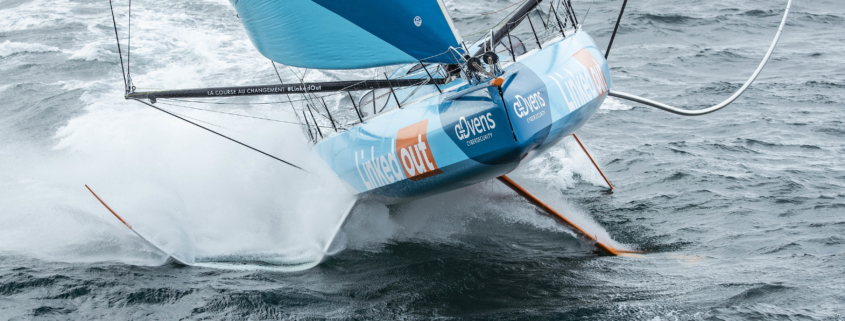Thomas Ruyant, unfinished Vendée Globe business and among the favourites
On the 2016 race Thomas Ruyant was lying eighth when his IMOCA60 memorably hit a floating object hard while he was west of New Zealand. With his boat progressively splitting in half he nursed it into Bluff, New Zealand.
Now Ruyant is back armed with a well sorted Verdier design LinkedOut which has proven highly potent. Third in the Vendée Arctique he is widely reckoned to be one of the podium contenders.
Thomas, how does it feel to be here at the dock?
“It’s nice to be here. This is the culmination of more than 3 years of work with a team that has grown over time. It has been a long project to set up but which has got more and more accomplished together, allowing me to now be quite chilled. I’m lucky to have a team which are very much in step with me and my outlook. We don’t leave anything to chance. It’s a real pleasure to work in these conditions. I feel like I have everything I need to do something great. This already feels a project destined for success.”
This is your second Vendée Globe start, do you feel like you are on familiar ground?
I don’t feel like I am used to being here at the Vendée Globe and no one will ever really be. My first experience was stopped and so I did not get round. I hope this time is good. Technically and sportingly, I’m up a level and it is something else. (Foiling) We are now in another world of modern sailing. We lift ourselves off the water and free ourselves from the drag from the surface of the water. At the same tune you have to be more and more into the fine detail to be able to handle this type of machine. I think I have the maturity now to take this on and be able to embark on a round-the-world race with this boat.
So you are up in the top division, the very leading group?
“Yes, that’s what we set out to do: setting up a high-performance project with a new boat, well designed, built, developed and optimized. We did what we had to do, put in the resources and the right people. We are one of the top boats of this race. It’s a great source of pride for me, for the team, the partners. Yes, that is a pressure, but a good pressure that gives me energy to operate at the level of my rivals. That is not a burden. It’s not a burden or a burden, it’s great to be with that label at the start. Even if I’m not the only one who can play in front.”
With your main partner Advens Technologie (cybersecurity specialist), have you developed systems? Are there things you have on board your boat that no one else has?
“On the boat, we have dozens of data measurements that are used for performance and safety. You have to know how to understand them, how to deal with them: the load in the rig to control the pressure in the mast, the deformation of the foils etc. Aerospace projects also have this type of information. Advens R&D teams stepped in to enable me to process this data quickly. On board the boat, I have a dashboard that summarizes all this information with color codes (green, orange, red) which allow, at a glance, to know where I am in order to take the correct decision quickly, including on my internet data consumption, data concerning my sleep. This is quick-to-read info and will help me with the 1000’s of things to do elsewhere. It will make my life easier. We also have the sleep aspect which is a huge priority to be efficient. We have boats that are starting to fly. But to fly you have to trim more and that takes a lot of energy. You have to be working hard in the cockpit to sail fast. You are talking about gaining several knots here and there and that can make a big gain. So finding the time to rest and to sleep are very important. You have to know when you can go. Until now it was feeling and knowing yourself through experience. Here we are trying to make things more scientific with data. I have a belt connected that will measure everything, giving me the actual sleep time (over the last 24 hours for example). It helps prevent burnout. And we get relevant and precise feedback.”
Comfort, protection, ergonomics?
“No protection other than a helmet that I put on to move around inside the boat, when going forward. Ergonomics, life on board, this is a subject that we have worked on a lot with the team. And as the technicians of the team are all sailors, guys who sail, they know the problems.
At the launch in 2019, nothing had been done for the ergonomics. We had to test how life on board was. We quickly realized that this was a big thing and so worked on it through the winter refit. We have a central pilot seat made to my size. This seat is placed between the two rope tunnels it is like a cocoon and what is different is that it is facing back. This allows it not to slam forward and better withstand all shocks. It is positioned on a ball joint which allows it to be oriented and pivoted in all directions. And so I have direct access to the cockpit. Everything is accessible from the seat: my “kitchen”, my workstation,… I can spend time watching and sleeping in this chair, but I can also sleep on a bunk, on either side of the tunnels.”
The last 33 hours of the 33 competitors
Sunday November 8 at 7 a.m. As I am fourth to leave the dock around 8:35 am. At 7 am, I will be with the two children and my partner. We are in a small house near the station. We will be at breakfast ‘. The last moments with the family. After a night when we usually are preoccupied with our thoughts a bit…
Source: Sail-world.com



